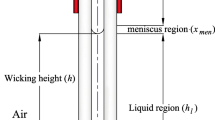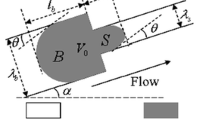Abstract
An analysis has been provided for the entropy generated for the micro/nano scale heat and mass transfer in a capillary tube in terms of the gradients of velocity, temperature and concentration as well as the physical properties of the fluid. The heat and mass transfer rates are assumed to be uniform on the surface of the capillary tube. The optimum tube diameter that corresponds to the minimization of entropy generated and minimization of fluid flow resistance is about 1 mm. We have applied the method of thermodynamic optimization to capillary driven systems. The objective was to identify the geometric configuration that maximized performance by minimizing the entropy generated when the flow rate is prescribed.









Similar content being viewed by others
Abbreviations
- a, b :
-
constants defined in Eq. (3)
- A :
-
dispersion constant (J)
- Be :
-
Bejan number
- C :
-
concentration (mol m−3)
- C p :
-
specific heat at constant pressure (J kg−1 K−1)
- h :
-
film thickness (m)
- h fg :
-
Latent heat of vaporization of the liquid (J/kg)
- k :
-
thermal conductivity (W m−1 K−1)
- K :
-
curvature (m−1)
- L :
-
length of plate (m)
- \( \mathop m\limits^. \) :
-
mass flux (kg m−2 s−1)
- \( \mathop m\limits^.{_{\rm d}}\) :
-
mass diffusion rate (kg m−2 s−1)
- M :
-
molecular weight (g mol−1)
- N :
-
entropy number
- p :
-
pressure (Pa)
- q ′′ :
-
heat flux (W m−2)
- R :
-
tube radius (m)
- R g :
-
universal gas constant (J/mol K)
- r :
-
radial coordinate (m)
- S′′′:
-
entropy generated (W m−3 K−1)
- T :
-
temperature (K)
- u :
-
velocity (m s−1)
- y :
-
distance measured from the tube surface (m)
- ρ :
-
density (kg/m3)
- μ :
-
absolute viscosity of liquid (kg m−1 s−1)
- ν :
-
kinematic viscosity of liquid (m2 s−1)
- ε:
-
Dimensionless film thickness (h/R)
- σ :
-
surface tension (N/m)
- ψ:
-
disjoining pressure
- γ :
-
surface tension gradient (N/m K)
- \( \bar \gamma \) :
-
evaporation coefficient
- A :
-
species A
- evap:
-
evaporative
- G:
-
generated
- L:
-
liquid phase
- x:
-
axial derivative
- V:
-
vapor phase
References
Derjaguin BV, Zorin ZM (1957) Optical study of the absorption and surface condensation of vapors in the vicinity of saturation on a smooth surface. In: Proceedings of the 2nd international congress on surface activity (London), vol 2, pp 145–152
Xu X, Carey VP (1990) Film evaporation from a microgrooved surface: an approximate heat transfer model and its comparison with experimental data. AIAA J Thermophys 4:512–520
Ha JM, Peterson GP (1996) The interline heat transfer of evaporating thin film along a micro grooved surface. ASME J Heat Transf 118:747–755
Park K, Noh KJ, Lee KS (2003) Transport phenomena in the thin film region of a micro channel. Int J Heat Mass Transf 46:2381–2388
Das Gupta S, Kim IY, Wayner PC (1994) Use of Kelvin–Clapeyron equation to model an evaporating curved microfilm. J Heat Transf Trans ASME 116:1007–1015
Longtin JP, Badran B, Gerner FM (1994) A one dimensional model of a micro heat pipe during steady state operation. ASME J Heat Transf 116:709–715
Sartre V, Zaghdoudi M, Lallemand M (2000) Effect of interfacial phenomena on evaporative heat transfer in micro heat pipes. Int J Therm Sci 39:498–504
Qu W, Ma T, Miao J, Wang J (2002) Effects of radius and heat transfer on the profile of evaporating thin liquid film and meniscus in capillary tubes. Int J Heat Mass Transf 45:1879–1887
Gorla RSR (1997) Heat transfer in thin liquid films. US Air Force, Wright laboratory, technical report WL-TM-97-3016
Gorla RSR, Gatica JE, Ghorashi B, Ineure P, Byrd L (2002) Heat transfer in thin liquid film in the presence of electric field for non-isothermal interfacial condition. Int J Fluid Mech Res 29:146–157
Gorla RSR, Byrd L (1999) Effect of electrostatic field on film rupture. Trans ASME J Fluids Eng 121:651–657
Honda H, Wang YS (2004) Theoretical study of evaporation of heat transfer in horizontal microfin tubes: stratified flow model. Int J Heat Mass Trans 47:3971–3983
Kandlikar SG, Raykoff T (1997) Predicting flow boiling heat transfer of refrigerants in microfin tubes. J Enhanced Heat Transf 4:257–268
Mukherjee A, Kandlikar SG (2005) Numerical simulation of growth of a vapor bubble during flow boiling of water in a microchannel. Microfluid Nanofluid 1:137–145
Hosoda M, Nishio S, Shirakashi R (1999) Meandering closed-loop heat transport tube. In: Proceedings of the 5th ASME/JSME joint thermal engineering conference, 15–19 March, San Diego, CA
Wong TN, Tong BY, Lim SM, Ooi KT (1999) Theoretical modeling of pulsating heat pipe. In: Proceedings of the 11th international heat pipe conference, Tokyo, Japan
Shafii MB, Faghri A, Zhang Y (2001) Thermal modeling of unlooped and looped pulsating heat pipes. ASME J Heat Transf 123:100–106
Zhang Y, Faghri A (2002) Heat transfer in a pulsating heat pipe with open end. Int J Heat Mass Transf 45:755–764
Bejan A (2000) Shape and structure from engineering to nature. Cambridge University Press, Cambridge
Bejan A (1982) Entropy generation through heat and fluid flow. Wiley, New York
Bejan A (1997) Advanced engineering thermodynamics. Wiley, New York
Bejan A (1996) Entropy generation minimization. CRC Press, Boca Raton
Ono S, Kondo S, (1906) Handbook of physics, vol 10. Springer, Berlin, pp 174–175
Hirschfelder JO, Curtiss CF, Bird RB (1954) Molecular theory of gases and liquids. Wiley, New York
Denbigh D (1981) The principle of chemical equilibrium. Cambridge University Press, Cambridge
Author information
Authors and Affiliations
Corresponding author
Appendix
Appendix
The general formulation for the local entropy generation per unit volume g, in an incompressible Newtonian fluid had been derived by Hirschfelder et al. [24], and is given as
where the first term is due to fluid friction and the second and third terms are due to mass diffusion and heat conduction. The fourth term arises from the coupling between heat and mass transfer, the fifth term is due to body forces, and the sixth term represents the effect due to chemical reactions.
Consider flow in a tube with heat transfer occurring at both walls. The chemical reactions and gravitational effects are neglected, and the fluid is considered to be a binary mixture of two ideal gases with species A diffusing perpendicular to the flow direction.
The chemical potential of species A can be expressed in the following form [25]:
where P A is the partial pressure of species A, and μ 0 A is the standard state chemical potential of pure species A at temperature T. If cp,A is constant, μ 0 A (T) can be expressed as
where P 0 and T 0 are the reference pressure and temperature, and h A0 and s A0 are the enthalpy and entropy of the diffusing species A, at T 0 and P 0.
Using Eqs. (21) and (22), the partial molar entropy of species A, \( \bar S_A, \) can be simplified as
where C 0 is the reference mass concentration at T 0 and P 0.
Substituting Eqs. (21)–(23) into Eq. (20), the local entropy generation g, in a tube flow with single species A, diffusing in the y-direction can be expressed as:
where term (1) is due to fluid friction, term (2) due to mass diffusion, term (3) due to the flux of heat, and term (4) due to the coupling effect between heat and mass transfer.
Rights and permissions
About this article
Cite this article
Gorla, R.S.R., Byrd, L.W. & Pratt, D.M. Entropy minimization in micro-scale evaporating thin liquid film in capillary tubes. Heat Mass Transfer 45, 131–138 (2008). https://doi.org/10.1007/s00231-008-0412-6
Received:
Accepted:
Published:
Issue Date:
DOI: https://doi.org/10.1007/s00231-008-0412-6




